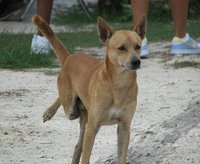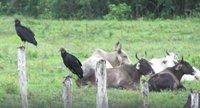_____
Wednesday, June 27, 2006: Lamanai
Awoke just before 6 AM. Horrible weather, very heavy rain and wind. If the weather stayed like that, we would not have been surprised if the whole trip was cancelled. Chagrined, but not surprised. Well, the rain declined and went away by 7 AM, and the wind reached a much more manageable level.
Our boat, “Seaduced,” arrived at around 7:30, and we were off. Our pilot, whose name might be Ray so that’s what we’ll call him here, was also our “tour guide” for the first leg, accompanied by Leon, who used the wind to dry out a pair of pants. Before we turned inland we saw islands of mangroves. Ray told us they protected from erosion from heavy waves and winds and from hurricanes. I caught a great picture of a pelican by accident, when I snapped a photo of a short, narrow passage we were about to pass through:
 As we headed inland, along a narrow river, Ray told us more about mangroves, and about some other flora and fauna. The mangroves are a fascinating plant: because of their importance to the country, you can’t cut them down, even on your own property, without governmental permission. They handle salinity very well, but need the nutrition from the silt. A mangrove will send out a “finger,” a single branch (of a sort) that will reach downward, until it touches water. Then it splits into more fingers, continuing down to take root in the silt.
As we headed inland, along a narrow river, Ray told us more about mangroves, and about some other flora and fauna. The mangroves are a fascinating plant: because of their importance to the country, you can’t cut them down, even on your own property, without governmental permission. They handle salinity very well, but need the nutrition from the silt. A mangrove will send out a “finger,” a single branch (of a sort) that will reach downward, until it touches water. Then it splits into more fingers, continuing down to take root in the silt.
We stopped in the town of Bomba -- a group of small shacks, a few people, some dogs. (Yes, the dog's leg is like that. Apparently it had been that way for a long time, because he got around quite well.) In Bomba we got onto an old school bus, driven by a guy named Ernesto.
(Yes, the dog's leg is like that. Apparently it had been that way for a long time, because he got around quite well.) In Bomba we got onto an old school bus, driven by a guy named Ernesto.
Along a bumpy road we learned that electricity s just starting to reach towns like Bomba, and that in each of these towns there is a school -- generally Catholic, the main religion in Belize -- and that parents can get arrested if their kids don’t attend school, and that the kids always wear uniforms. We also stopped where we could buy roasted cashews for a couple of bucks. Good cashews.
About cashews: the cashew seed -- the nut that we eat -- is outside of the fruit, the only fruit of its kind. Apparently the fruit is quite edible. But it is very acidic, according to Ray, and tough on the fingernails. The smoke from roasting them is also, over time, harmful to those doing the roasting, though I didn’t catch how.
Along our way we passed the Maruba Resort, which, according to Ray, is a rather hedonistic destination. We also saw a cattle farm (“grass fed, lean beef”) and numerous vultures. Some time later, we boarded another boat. Ray and Leon were still with us, and Ernesto stayed behind. Our new pilot and tour guide was Eduardo -- “Eddie.”
Some time later, we boarded another boat. Ray and Leon were still with us, and Ernesto stayed behind. Our new pilot and tour guide was Eduardo -- “Eddie.”
As we headed down the New River, we saw the Saw Palmetto plant (good for the prostate, in case you hadn‘t heard by now) and the Northern Jacana -- a beautiful little wading bird, also called the Jesus Bird because it looks like it walks on water.
We eventually came into a lake, stopped at a pier at the Lamanai Archeological Park.
But first: Lunch! Rice and beans, fried plantains (taste-wise, the yummy love-child of fried apples and bananas), salad, and a choice of Coke, Fanta, water, and Belikin Beer -- the only Belizian beer. Of course, I had the beer. And then we hike. “Lamanai,” by the way, is a mispronunciation by the Spanish, said Eddie. The Mayans probably said something more like “Lamanain” -- “la-man’ a-een’ .” Lamanai(n) was built on a bunch of rocks -- the Mayans carted in a heck of a lot of rock to create a platform for the city comfortably above the level of the water (no flooding, great view of the countryside) and then built the city on top of that. The first thing we saw was a good-sized pyramid, so I thought -- --but later we came to the big temple which rose to 107 (?) ft. above the platform. And we could climb it! -- which, of course, Jenny and I did, accenting our climb with a quick romantic kiss at the top, and a moment to appreciate the view. The angle of the pyramid, with the height, was enough to kick in a slight fear of heights, so I didn’t mind coming down. But that was a thrill, and I’d love to do it again.
--but later we came to the big temple which rose to 107 (?) ft. above the platform. And we could climb it! -- which, of course, Jenny and I did, accenting our climb with a quick romantic kiss at the top, and a moment to appreciate the view. The angle of the pyramid, with the height, was enough to kick in a slight fear of heights, so I didn’t mind coming down. But that was a thrill, and I’d love to do it again.
At Lamanai we also saw a toucan and a family of howler monkeys! Unfortunately the battery on my camera gave out before I could get a picture of the animals, or the big temple, or the *** palm (can't recall the name), which has the biggest leaves in the world* -- up to 35 ft., said Eddie [*actually, I researched this and he's incorrect -- the Raffia palm in tropical Africa has leaves up to 80 ft., but still . . . ]. Humongous palm leaves! Huge!
The return trip to San Pedro was also lovely, but fairly uneventful (except for a brief stop on the bus trip to view a juvenile alligator from a distance). We were tired tourists, relaxing and drinking rum punch. Going from the mainland back to Ambergris Caye we hit some choppy water. I, of course, sat in the front of the boat to feel the wind in my face and get the best bounce as we sped along. I felt like a giddy 12-year-old. Or a happy Labrador. The boat slapped the water hard enough that the next day my rear felt like it had gotten a spanking. Heh.
Still to come -- the final, legal ceremony, and manatees! And maybe a touch more after that . . .

1 comment:
And don't forget to mention that at the current rate of growth, the Mangroves will close off the estuary that we traveled to go to Lamanain within the next 60-80 years. (as quoted by our guide Eddie)
Oh, and you can't forget to tell everyone about our wonderful experiences on the "Manatee Tour".
Post a Comment